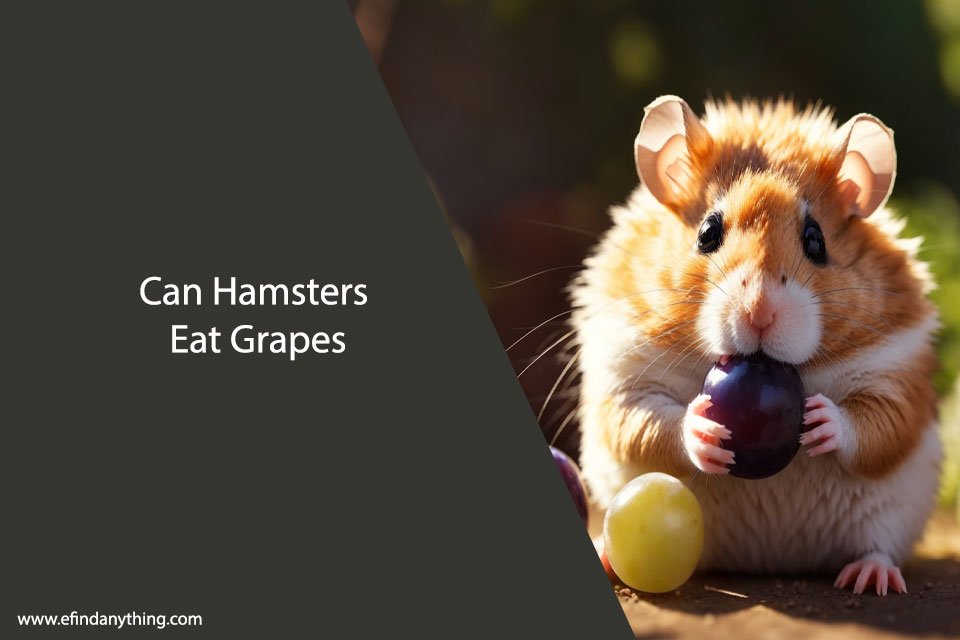Hamsters make adorable and playful pets, and ensuring their well-being includes providing them with a proper diet. As a responsible hamster owner, you might be wondering whether grapes can be a safe and suitable addition to your furry friend’s menu. This comprehensive guide will delve into the various aspects of hamster nutrition, the nutritional composition of grapes, potential benefits, risks, and how to incorporate grapes into your hamster’s diet.

Hamsters are small rodents that belong to the subfamily Cricetinae. They have specific dietary requirements to maintain their health and vitality. While a significant portion of their diet comprises commercial hamster pellets and fresh water, offering occasional treats like fruits can be a delightful experience for both you and your hamster.
Table of Contents
Understanding Hamster Diet
Hamsters are omnivores with a preference for seeds, grains, and fruits in the wild. In captivity, their diet often consists of commercial hamster pellets that are formulated to provide essential nutrients. These pellets serve as a foundation, but offering a variety of fresh foods can enhance their diet and prevent monotony.
Nutritional Composition of Grapes
Grapes are juicy and flavorful fruits enjoyed by humans worldwide. They contain vitamins like vitamin C and vitamin K, as well as minerals such as potassium and antioxidants like resveratrol. Additionally, grapes have natural sugars and dietary fiber that contribute to their overall nutritional profile.
Can Hamsters Eat Grapes?
Yes, hamsters can eat grapes, but in moderation. Grapes can provide a small dose of vitamins and minerals that can complement their diet. However, it’s important to remember that hamsters have sensitive digestive systems. Introduce grapes gradually to monitor how your hamster responds.
Health Benefits of Grapes for Hamsters
When given in appropriate amounts, grapes can offer some health benefits to hamsters. The vitamins and minerals in grapes can contribute to their overall well-being. Vitamin C supports the immune system, while antioxidants like resveratrol have potential health-promoting properties.
Potential Risks and Concerns
While grapes can be a tasty treat, there are potential risks to consider. Grapes contain natural sugars that could lead to weight gain or digestive upset if consumed excessively. Additionally, grapes have small seeds that can pose a choking hazard. Always ensure grapes are seedless and cut them into small, manageable pieces.
Moderation and Serving Guidelines
The key to incorporating grapes into your hamster’s diet is moderation. Offer grapes as an occasional treat, not a primary food source. A small, seedless grape cut into tiny pieces is an appropriate serving size. A good rule of thumb is to provide a piece no larger than your hamster’s cheek pouch.
Alternative Fruits for Hamsters
If you’re looking for variety beyond grapes, there are other fruits suitable for hamsters. These include small pieces of apple, pear, banana, and blueberries. Always research before introducing new foods to ensure they are safe for your furry friend.
Observing Your Hamster’s Reaction
Every hamster is unique, and their reactions to different foods can vary. After offering a small piece of grape, observe your hamster closely. If there are no signs of discomfort, digestive upset, or changes in behavior, it’s likely that grapes can be a part of your hamster’s treat rotation.

Conclusion
In conclusion, grapes can be a safe and enjoyable treat for your hamster when offered in moderation and prepared appropriately. Their nutritional benefits can complement the hamster’s diet, but it’s crucial to be aware of the potential risks and always prioritize your hamster’s well-being. Remember to consult with a veterinarian if you’re uncertain about introducing new foods to your pet.





